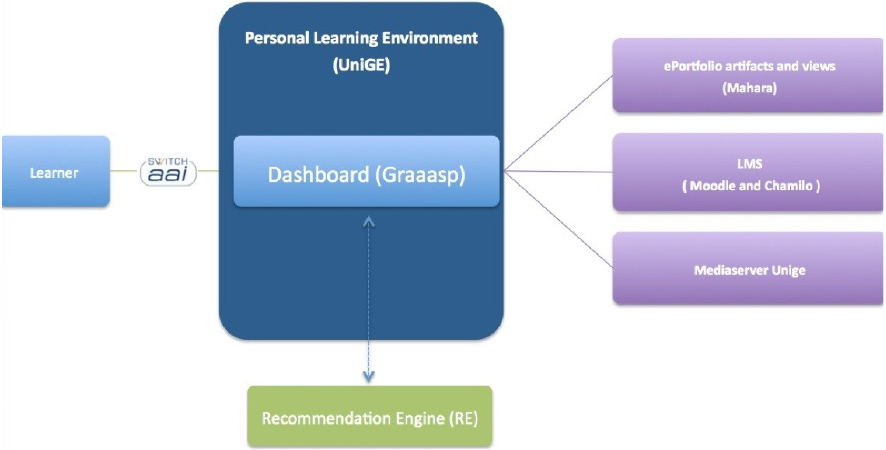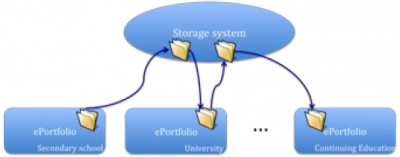Technical Solutions
The technical solutions for implementing the dashboard will rely (at least in a first stage) on the Graaasp social media platform. Graaasp is developed by EPFL in the framework of the ROLE European project on responsive open learning environment. The Graaasp infrastructure is hosted and managed at EPFL by the React group (at least for the duration of the ROLE project). Graaasp API is open source and will continued to be developed through other projects. To cope with the institutional constraints and to deploy a scalable solution, it is envisioned to implement a server of the Graaasp social media platform in each institution or alternatively to host a Graaasp server at Switch.
The current version of Graaasp cannot interface the UNIGE and UNIFR institutional tools and resources. Thus Graaasp needs to be adapted and extended in order to supports external tools such as Chamilo, Mahara, Moodle. Similarly, the recommendation engine (RE) needs to be enhanced accordingly to support the new types of institutional actions/entities. In addition, its internal algorithm must be customize and tuned to take these new types into consideration.
Graaasp: Common solution adopted for the Dashboard
Graaasp’s main purpose is to support self-directed learners and knowledge workers in their daily online learning and knowledge management practices. It relies on resources gathered from the Web and online communities. Graaasp enables the aggregation, the sharing and the interaction with a rich set a resources in private of public contexts defined by the learners themselves. Assets, activities, Web apps and people can be associated for a given purpose. Graaasp supports typical Web 2.0 features such as the rating, the tagging, and the commenting of resources and people.
Recommendation Engine
The main technological objective of the recommendation engine (RE) is to provide contextual recommendation for the aggregation of relevant educational resources, applications, experts and activities. The RE exploits inter-relations between 3A entities that confer interest. Relevance is measured relatively to the target user’s context and their reputation, and more importantly within the target user’s network.
Graaasp/RE <--> Institutional Tools @ UNIFR (Moodle)
Moodle is the official LMS of UNIFR (and is also in use at UNIGE and EPFL). A migration to Moodle 2 is currently being planned. New APIs provided by Moodle 2 should facilitate communication between Moodle and Graaasp. Development will thus be performed using Moodle 2.
Integration of Moodle and Graaasp-RE consists of two main parts : the feeding of the recommendation engine with Moodle data, and displaying specific Moodle information inside Graaasp.
RE <--> institutional tools @ UNIGE (Chamilo, Mahara, Moodle)
Current Infrastructure : The UNIGE elearning infrastructure is primarly made of two LMSs - Moodle and Dokeos - an ePortfolio - Mahara - and a streaming platform - Mediaserver. Dokeos is the most widly used LMS accounting for about 90% of all users. UNIGE intends to migrate Moodle to version 2.0 during summer 2011, and Dokeos to Chamilo (new version of Dokeos) in the near future. Developments will thus target Moodle 2.0 and Chamilo.
Future Infrastructure : The objective is to deploy the dashboard (Graasp, RE) at UNIGE and enable the current architecture to communicate with it while keeping the infrastructure as much independent as possible. For this to happen, the existing infrastructure must be adapted to support communication and integration, as shown in Fig. 6.

Sustainability and Integration
One of the goal pursued by this project is to reduce the dependency between different parts of the infrastructure. The reason for that is to maximize reuse and ensure stability if one of the part becomes obsolete in the future.
This goal is achieved by leveraging existing protocols and developing widgets that can be embedded in a large class of applications. As an example a set of technologies, already well supported by several key players such as Youtube, iGoogle, Dailymotion or Facebook, have already been identified: oEmbed, Open Graph Protocol, Open Social and IFrames. Those technologies should ensure some stability over time.
Another facet of sustainability concerns the ePortfolio in the context of Life Long Learning (LLL), where it is essential to ensure accessibility of students’ porfolio during and beyond their curriculum. Particularly, it is crucial that students (and lecturers) who change institutions can take with them their artefacts (production, progression data, peer comments and teachers commentaries, learning outcomes, etc. ). In some cases, it might even be necessary to store users’ property outside their workplace/institution. We thus have to find a practical solution, such as for instance a centralized eportfolio storage system, which could ensure the importation/exportation of any portfolios, as shown in Fig. 9. However, to find the solution best suited to institutional needs, we will perform a feasibility study, performed by the UNIGE and piloted by the SIG-ePortfolio, which will take into account
- the identification of common needs across all the involved institutions;
- various LLL scenarios, which involve the use of ePortfolios and the way the students’ artifacts have to be moved from one ePortfolio to another
- the design of a conceptual model, if possible along IMS standards (or LEAP2A) to facilitate later integration with other institutions.


